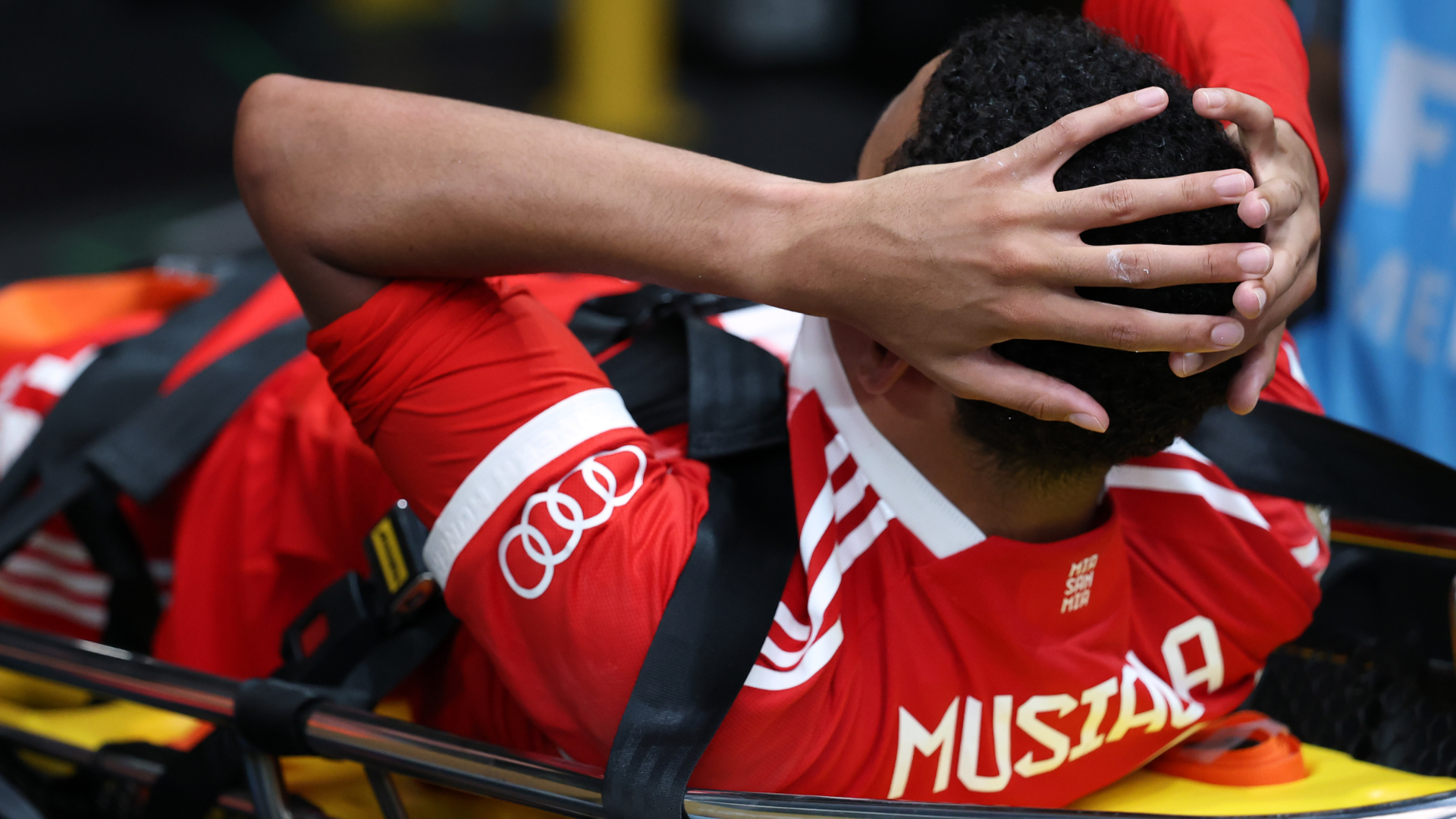Jamal Musiala Injury Sidelines Bayern Ace for Up to Five Months
Jamal Musiala injury has delivered a major blow to Bayern Munich’s pre-season plans, with the gifted playmaker set to miss four to five months after fracturing his left fibula and damaging ankle ligaments during the FIFA Club World Cup in Atlanta.
Extent of the Jamal Musiala Injury and How It Happened
The 22-year-old Germany international collided awkwardly with Paris Saint-Germain goalkeeper Gianluigi Donnarumma while chasing a loose ball late in the first half at Mercedes-Benz Stadium. Television replays showed the attacker’s ankle twisting underneath the heavyweight keeper, immediately sparking concern among team-mates and medical staff. Diagnosed with a clean fibula break plus multiple torn ligaments, the Jamal Musiala injury was confirmed after scans at an Atlanta hospital. Club officials swiftly ruled him out of the remainder of the tournament, and he has since flown back to Munich for surgery.
Bayern Munich’s Initial Response to the Jamal Musiala Injury
Sporting director Christoph Freund described the news as “gut-wrenching,” while new head coach Vincent Kompany admitted his “blood boils” at losing a central figure in his 4-2-3-1 system. Musiala, who had just inherited the famous No.10 shirt from Leroy Sané, was pencilled in as the creative heart of Bayern’s rebuild. His absence now forces Kompany to reshuffle his entire midfield and attack before the 2025-26 Bundesliga kicks off.
Tactical Adjustments on the Horizon
1. Thomas Müller could reclaim the No.10 role in the short term, offering leadership and pressing intensity.
2. Jamal Musiala injury may accelerate Bayern’s pursuit of a new attacking midfielder, with rumors linking Florian Wirtz and João Neves to the Allianz Arena.
3. Kompany could experiment with a double-pivot featuring Joshua Kimmich and Konrad Laimer, freeing Sané or Serge Gnabry to drift centrally.
Recovery Timeline & Medical Perspective
Orthopedic specialists estimate a 16-to-20-week recovery window for a broken fibula combined with ligament reconstruction. The rehabilitation plan is likely to unfold in four phases:
Phase 1: Post-Surgery Stabilization (Weeks 0-4)
• Musiala will remain non-weight-bearing, focusing on reducing swelling and maintaining upper-body conditioning.
• Hydrotherapy and gentle range-of-motion exercises will begin once stitches are removed.
Phase 2: Controlled Loading (Weeks 5-10)
• Light weight-bearing in a protective boot, followed by progressive walking drills.
• Introduction of anti-gravity treadmill sessions to restore gait mechanics.
Phase 3: Strength & Proprioception (Weeks 11-16)
• Gym-based work to rebuild calf strength and ankle stability.
• Sport-specific movements such as shuttle runs, lateral cuts, and ball-handling under supervision.
Phase 4: Return-to-Play Integration (Weeks 17-20)
• Full-contact training once medical staff approve load-bearing metrics.
• Final clearance will depend on pain-free mobility, explosive sprint data, and psychological readiness.
Any setback—such as joint stiffness or scar-tissue irritation—could stretch the Jamal Musiala injury recovery into early 2026, jeopardizing his participation in the crucial Champions League group stage.
Financial and Squad Implications for Bayern
Bayern had budgeted for a quiet summer after heavy spending last year, but the Jamal Musiala injury may reopen the transfer tap. Insurance will cover part of his €8 million annual salary during lay-off, yet the club risks sporting revenue losses if early-season results falter. Young talents such as Paul Wanner and Arijon Ibrahimović are now poised to receive extended minutes, while academy coaches have been instructed to accelerate development programs.
Impact on Germany’s Euro 2026 Preparations
With Germany already planning for the expanded European Championship in Spain and Portugal, national coach Julian Nagelsmann must monitor Musiala’s rehab closely. The Jamal Musiala injury removes a guaranteed starter from autumn qualifiers against Italy and Croatia, forcing tactical tweaks that could influence squad chemistry. Nagelsmann may test Bayer Leverkusen’s Wirtz in the central pocket or push Kai Havertz back into an attacking-midfield berth.
Historical Context: Bayern’s Recent Injury Woes
Over the past decade Bayern have weathered high-profile injuries to Franck Ribéry, Manuel Neuer, and Alphonso Davies, yet still captured domestic and European honors. However, data from 2023-24 showed a 14% rise in soft-tissue injuries due to the compressed calendar. The Jamal Musiala injury underscores growing calls for schedule reform, with FIFPRO warning of “unsustainable player loads” after the expanded Club World Cup and forthcoming FIFA calendar changes.
Lessons Learned
• Rotational depth must improve; relying on a single creative fulcrum is risky.
• Early detection of fatigue markers could prevent overload situations leading to catastrophic contact injuries.
• Transparent communication between club and country medical departments is essential to streamline rehabilitation.
Opinion: A Test of Bayern’s Long-Term Vision
Losing Musiala for nearly half a season is a hammer blow, but it also presents a litmus test for Bayern’s famed squad-building ethos. Kompany’s adaptive tactics and the board’s willingness to invest smartly will determine whether the champions maintain their domestic dominance and European relevance. If the next generation steps up, the Jamal Musiala injury may, paradoxically, spark the emergence of fresh heroes at the Allianz Arena.
Your global gateway to nonstop football coverage:
Goal Sports News
Share this content:
